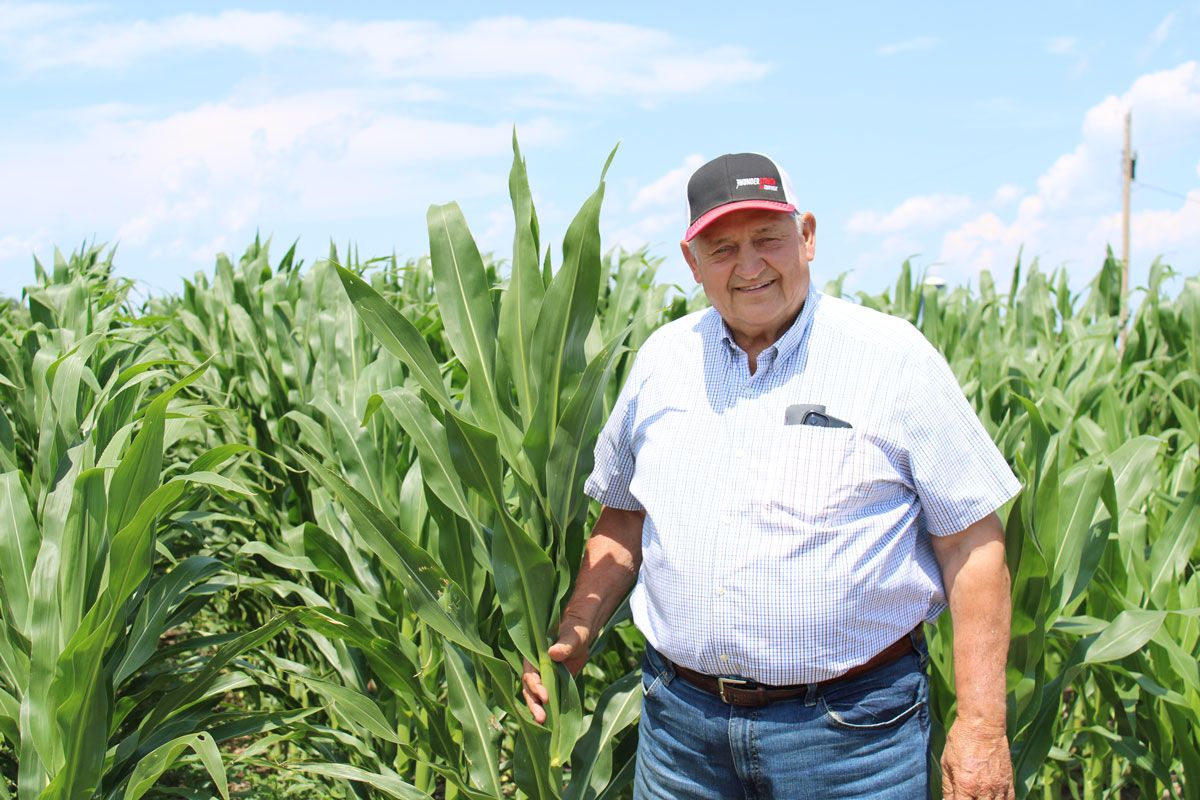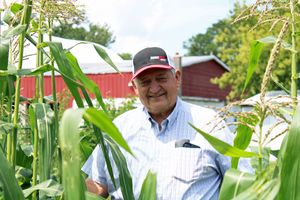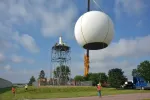Farmers in South Dakota and across the U.S. will likely take home less income this year because of increasing input costs and decreasing commodity prices. However, halfway through the growing season, some are optimistic the state could have a good year if the weather cooperates.
“We’re relying on rain throughout the growing season, but for right now, it’s so far, so good. If we continue to get rains, we should have a pretty good crop,” said Glenn Storm, who grows corn and soybeans east of Corsica.
The U.S. Department of Agriculture’s 2023 Farm Income Forecast from February said it expects net farm income to drop nationwide by $30.5 billion in inflation-adjusted dollars in 2023. Net farm income reflects an operation’s income after production expenses from the year have been subtracted. However, this year’s projected net cash farm income is almost $29 billion above the 2002-2021 average.
More from News Watch: Age of South Dakota farmers rise – along with land and input costs
For the Northern Great Plains, the USDA forecasts a 12% drop in net cash income for farm businesses.
The predicted decrease would follow 2022’s record high forecasted net cash farm income of $195.3 billion. Crop prices surged around the country last year after Russia invaded Ukraine, one of the world’s top agricultural producers.
“There’s always challenges that farmers and ranchers face across our state, and one of the best things that our producers do is step up to those challenges and find ways to overcome them,” said Heather Gessner, a livestock business management field specialist at South Dakota State University Extension.
Income’s fate depends on production
With a recent decline in corn and soybean prices, stable production could help net farm income levels remain steady throughout 2023, Gessner said.
“On an individual basis, (net farm income) is probably going to vary quite a bit. But as a whole, we’ll probably be somewhere in that normal type of range,” Gessner said.
Both Gessner and Dave Schriever, vice president at First National Bank in Philip, in western South Dakota, said it’s too early in the season to know if the net farm income for South Dakota will see a decrease this year.
“If production is good and the price is lower, you can still have a pretty good gross profit. The worst thing that can happen is if prices are low and you’re in the part of the country where production is weak. It’s kind of a double whammy then,” Schriever said.

Corn, soybean price declines contribute to lower income predictions
Cash receipts, which reflect the cash income farmers receive from commodity sales, for both crops and animal products are forecast to decrease this year by about 4%.
Corn and soybean cash receipts are projected to decrease nationally by 7.1% and 10.6%, respectively. However, prices will still remain relatively high in comparison to previous years.
“Unfortunately, over the last couple weeks, corn has lost about a dollar and a half a bushel, so that’s kind of a challenge,” Storm said.
The latest trends:
- The price for South Dakota corn per bushel decreased by 9.6% from May 2022 to May 2023, according to USDA data.
- The price received for soybeans per bushel in South Dakota this May rang in at nearly 12% lower than the price in May 2022.
- Sunflowers in South Dakota received roughly 39.7% fewer dollars per hundred pounds this May than in May 2022.

Schriever said the lower crop prices result from a global supply and demand pattern. When agricultural regions throughout the world experience quality moisture levels, production tends to go up and prices go down, he said.
“This year, prices are lower. They’re still higher than what we’ve seen sometimes in the past. But they need to be at this level or better in order to show a profit with these extra costs and the inflation that’s with us right now,” Schriever said.
Production costs rising across the United States
Lower cash receipts throughout the nation won’t be the only challenge for the state’s farmers this season.
Total production costs, the expenses required for items like fuel and feed, are expected to see a slight increase of 1.3% in inflation-adjusted terms. However, the USDA forecasts these expenses to have increased by 11% from 2021 to 2022.
Expenses for fertilizer, feed and fuel are expected to decrease this year from 2022’s heights but remain high, according to the USDA.
“Everything, even parts, any kind of repair parts or machinery, is really high-priced and sometimes it takes a while to get it,” Storm said.
Among the costs for Plains farmers, according to USDA:
- Producers spent about $3.25 billion dollars on fuel in 2021, which is up from the $2.69 billion from 2020 and $2.78 billion spent in 2019.
- Fertilizer totals reached $7 billion in 2021, which is up from the nearly $5.6 billion spent in 2020 and the $5.4 billion spent in 2019.
- Plains farmers spent over $14 billion on feed in 2021, which is up from the nearly $11 billion spent in 2020 and the $12.25 billion spent in 2019.

Throughout the COVID-19 pandemic, farmers saw higher fuel costs and slow supply chains. Gessner said expensive fuel prices caused suppliers to increase their prices to account for rising shipping costs.
“There are certain things you can do without, for some time at least, but most of the stuff a farmer or rancher needs, they have to buy. So they pay the extra cost and hopefully they can make it up in the end when they sell their products,” Schriever said.
Farmers throughout the state are having to adjust to the normal that is higher production costs.
“You have to try and make the best of it. You have to try and keep a positive outlook. I mean, that’s the only thing that keeps a farmer going. If you had a bad outlook, you wouldn’t be putting seed in the ground,” said Ron Neugebauer, who grows corn and soybeans near Dimock.
Cattle market sees success
While production costs remain high across the nation, many say the cattle market is flourishing in South Dakota.
“The cattle markets are as strong as they’ve been in nearly 10 years, and it looks to stay that way through the fall,” Schriever said.

Cattle receipts are expected to remain relatively stable in 2023, according to the Farm Income Forecast.
According to data gathered by South Dakota State University Extension, cash prices for feeder cattle in South Dakota increased by an average of 15.6% from 2021 to 2022.
However, the number of cattle in the state has fallen from 4 million in 2021 to 3.55 million in 2023, according to USDA data. Gessner said several years of drought, which led to more expensive hay prices, encouraged some farmers to reduce their herd sizes.
The decrease in cattle numbers has supported the higher cash receipts for cattle, she said, as the demand for beef remains high.

Only weather will tell
Despite the various forecasts for agriculture in 2023, much of the success for South Dakota’s No. 1 industry hinges on the weather.
While the state did see plenty of snowfall this winter, Gessner and Storm said it wasn’t enough to provide moisture throughout the dry spring.
“We did have some snow, but it was probably only a third of what we needed to catch up and to break even from last year’s drought. So while it was snowy and it was a pain, it wasn’t enough snow to compensate for the amount of moisture that we were missing,” Gessner said.
Neugebauer said the rainfall has varied this year at his farm.
Early in the spring, he said he got a 3-inch rain. When Dimock, which is about 10 miles from Neugebauer’s property, got up to 5 inches of rain, his area only got 1.
“You can have all the modern technology and all the modern things, and we still have to rely on the good Lord for the moisture from above to make things work,” Neugebauer said.
As of July 4, roughly 51% of the state was experiencing abnormally dry conditions to an extreme drought, according to the U.S. Drought Monitor. This dryness prevails throughout the eastern half of South Dakota.
Most of the west, however, has seen its fair share of rainy weather.
“Especially in late May and in June, (the west) just was in a pattern where they got consistent thunderstorm activity day in and day out,” said Phil Schumacher, a meteorologist at the National Weather Service in Sioux Falls.
The state and its farmers will need widespread rainfall to ease dry conditions, he said.
South Dakota could expect a chance for more consistent rainfall in August and September across the eastern side of the state, Schumacher said.
“It’s not a guarantee. But there may be a little bit of hope for some improvement as we head into the latter half of summer here,” he said.







